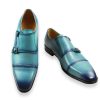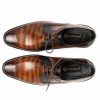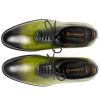The Unmatched Advantages of Handcrafted Footwear
Superior Materials & Construction
Handcrafted shoes prioritize premium materials like full-grain leather, vegetable-tanned hides, and natural rubber. Artisans meticulously select hides for uniformity and durability, avoiding corrected grains or synthetics common in mass production. This results in breathable, flexible footwear that molds to the wearer’s feet over time, reducing blisters and discomfort 128. Traditional techniques like Goodyear welting allow soles to be replaced multiple times, extending a shoe’s lifespan to decades—unlike glued soles in machine-made alternatives 26.
Economic & Health Value
While upfront costs are higher (€300–€1,000+), the long-term value is undeniable. A cost-per-wear analysis shows handcrafted shoes become economical within 2–3 years due to their durability. For example:
-
Resoling potential: 3–5 repairs vs. disposable fast fashion 27.
-
Medical benefits: Custom lasts accommodate bunions, high arches, or diabetes-related foot issues, reducing pain and improving posture 37.
Table: Handcrafted vs. Machine-Made Shoes
| Feature | Handcrafted | Machine-Made |
|---|---|---|
| Materials | Full-grain leather, natural dyes | Corrected leather, synthetics |
| Lifespan | 15–40 years (with care) | 1–3 years |
| Resoleability | Yes (Goodyear/Blake stitch) | Rarely |
| Custom Fit | Bespoke options available | Standard sizes only |
Sustainability & Ethics
Artisans use locally sourced materials, reducing carbon footprints. Vegetable tanning avoids toxic chromium, and minimal waste is generated through precise cutting. Ethically, handmade shoes support fair wages and cultural preservation—e.g., Italy’s scuola calzaturiera traditions 468.
2. Mastering Leather Shoe Care: A Ritual for Longevity
The Science of Preservation
Leather is a living material requiring hydration. Neglect causes fibers to crack, but pH-balanced conditioners replenish lost oils. Cedar shoe trees absorb moisture and maintain shape, while horsehair brushes lift dirt without scratching 15.
Step-by-Step Maintenance Ritual
-
Daily: Brush with horsehair after wear; use trees for 24 hours.
-
Monthly: Apply cream polish to nourish leather and mask scuffs.
-
Seasonally: Condition with products like Saphir Renovateur.
-
Annually: Professional resoling before soles wear thin 57.
Addressing Environmental Threats
-
Salt stains: Wipe with vinegar-water solution.
-
Rain: Air-dry away from heat; condition afterward.
-
Mold: Treat with diluted alcohol, then hydrate 6.
Key Insight: “A €500 shoe resoled three times over 20 years costs €25/year—cheaper than replacing €100 shoes annually” 7.
3. History of Handmade Footwear: From Ancient Craft to Modern Art
Evolution of Techniques
Shoemaking dates to 5,500-year-old Armenian leather discoveries. Medieval European guilds (e.g., Cordwainers) established quality standards, while 18th-century bespoke shoemakers like John Lobb catered to aristocracy. Industrialization introduced sewing machines (1850s), but artisans preserved hand-stitching methods like norvegese welting for flexibility 48.
Cultural Legacy
-
Italy: Renaissance-era workshops developed signature lasts and patinas.
-
England: Northamptonshire’s factories fused machine precision with hand-finishing.
-
Japan: Tokujitsu craftsmen adapted European Goodyear welting for kimono-compatible designs 48.
Modern Revival
Digital platforms (e.g., Feit Direct, Jose Real Shoes) now connect artisans with global audiences. Social media showcases behind-the-scenes craftsmanship, driving demand for heritage styles like monk straps or brogues 48.
4. Fashion Trends: The Timeless Versatility of Leather Footwear
Enduring Styles
Classic silhouettes—Oxfords, loafers, Chelsea boots—remain staples due to their adaptability. Recent trends include:
-
Chunky soles: Combined with streamlined uppers for contrast.
-
Mixed materials: Suede panels on calfskin.
-
Artisanal patinas: Hand-painted finishes that evolve with wear 58.
Capsule Wardrobe Integration
Three pairs cover 90% of needs:
-
Black Oxfords: For formal events.
-
Tan Derbies: Business-casual versatility.
-
Burgundy Loafers: Smart-casual elegance 5.
Customization Boom
Bespoke services offer:
-
Monogrammed insoles.
-
Exotic skins (e.g., ostrich, stingray).
-
Personalized lasts for unique toe shapes 37.
5. Eco-Friendly Shoe Production: Beyond Greenwashing
Sustainable Practices
-
Material sourcing: Vegetable-tanned leather (Tuscany’s concia vegetale) uses tree barks instead of chromium 46.
-
Waste reduction: Artisans repurpose leather scraps into keychains or patches.
-
Carbon footprint: Local production emits 60% less CO₂ than global supply chains 4.
Ethical Dimensions
Fair-trade cooperatives in Spain (e.g., Gabarain) and Italy preserve generational skills while ensuring living wages. Blockchain tracing now verifies leather origins, combating exploitative labor 16.
Consumer Action Guide
-
Ask makers: “Where is your leather tanned?”
-
Certifications: Look for Leather Working Group (LWG) tags.
-
Repair, don’t replace: Support local cobblers 46.
Key Takeaways
-
Investment Mindset: Handcrafted shoes cost more upfront but offer decades of wear and unique comfort.
-
Proactive Care: Simple rituals prevent deterioration, maximizing value.
-
Cultural Stewardship: Each purchase supports endangered artisanal traditions.
-
Sustainable Choice: Natural materials and repairability reduce fashion waste.
“A handmade shoe is not just footwear—it’s a wearable legacy”












